A cue is available from the stance taken by SC itself in case of unpaid dues from public sector undertakings (PSUs) such as Gas Authority of India (GAIL), etc.

The licence fee and SUC is charged as a percentage of service provider’s adjusted gross revenue (AGR)—8% and 3-5% respectively.
During the last three years or so, the telecom industry has been enduring an unprecedented crisis, with most of the companies having huge debt in their books and not generating adequate cash flows for servicing the loans. The crisis was aggravated by an order of the Supreme Court (SC) on October 24, 2019, directing telecom firms to pay ‘unpaid’ dues towards licence fee and spectrum usage charges (SUC). The licence fee and SUC is charged as a percentage of service provider’s adjusted gross revenue (AGR)—8% and 3-5% respectively.
The order was the culmination of a long-drawn court battle between the department of telecommunication (DoT) and service providers with the former insisting that for determining license fee and SUC, apart from telecom services revenue, AGR should also include revenue from non-telecom services viz. rent, profit on the sale of fixed assets, dividend, interest, etc, the latter opposed it. The SC upheld the DoT’s view.
The service providers are required to pay excess amount, which works out to Rs 53,000 crore for Vodafone Idea Limited (VIL); Rs 36,000 crore for Airtel. However, for Reliance Jio (RJio)—another dominant player—this is negligible at Rs 13 crore.
Unable to bear the resultant loss, Vodafone opined ‘without any government relief, the future of Indian JV was in doubt, and the global telco won’t be infusing any further equity into the venture’. Airtel too posted a heavy loss. The efforts of these firms to get the order modified or secure relief in making payments have not succeeded.
The woes of telecom operators are often blamed on the high burden of government levies. But, looking at this alone would be misleading. If that were the case, RJio wouldn’t be going so strong. During 2019-20, it posted a net profit of Rs 5,500 crore. The real culprits are the policies and regulatory environment that have favoured one player even while targeting others.
On the policy front, even as other operators paid gargantuan sums for obtaining license and spectrum, RJio got these at a throwaway price.
It acquired an internet service provider (ISP) license from an unknown entity, Infotel Broadband Services Pvt Ltd (IBSPL) in 2010, and got with it pan-India broadband wireless spectrum (BWA) by paying Rs 12,837 crore. In 2013, this was converted into a unified license (UL) to provide voice services also by paying an additional fee of a mere Rs 1,658 crore—a price that telcos paid in 2001.
On the regulatory front too, the Telecom Regulatory Authority of India (TRAI) went out of its way to favour RJio. In September 2016, in a bizarre move rarely seen before, RJio entered the market with ‘free’ and ‘unlimited’ voice calls and low-cost data—a brazen case of ‘predatory’ pricing.
The incumbent operators were forced to reduce tariff to match RJio. This pushed majority of them into the red. Many downed shutters while others were bought over.
In February 2018, TRAI amended the Telecom Tariff Order (TTO) to define a firm to be predator, if in a relevant market (circle), (i) it offers services at less than its average variable cost (AVC) and (ii) controls 30% market share or above’. During 2017-18, even as all firms were selling below AVC, incumbent operators had a market share > 30% whereas, RJio had a share of < 30%. In the eyes of the regulator, the former were predators even as the latter was not!
The amended order being ‘one-sided’ and ‘discriminatory’ was set aside by the Telecom Disputes Settlement Appellate Tribunal (TDSAT). But, by the time TDSAT gave its verdict (December 13, 2018), the damage was already done.
The inevitable outcome of these actions are: from over a dozen prior to RJio’s entry, the number of service providers has plunged to three viz. VIL, Airtel besides RJio. Of these, VIL is on the brink even as Airtel is struggling to keep its head above water. The hike in tariff—by all the three operators in December 2019—by up to 50% may have given some breathing space, but the unpaid dues as per SC order hangs like the proverbial ‘Damocles Sword’.
At < $2 per GB, the tariff in India is a fraction of what customers pay in other countries. But, a mere two operators for a population of 1.35 billion does not augur well. The global experience shows that in markets with fewer operators, tariffs tend to be high. Under a duopoly, the risk of a steep increase will remain. This must be corrected.
Ideally, we should aim at six firms. But, for now, the focus should be on ensuring that there are at least three. Further hike in tariff and cut in levies will help. However, it won’t be possible to salvage VIL/Airtel unless the load of the SC order is eased.
A cue is available from the stance taken by SC itself in case of unpaid dues from public sector undertakings (PSUs) such as Gas Authority of India (GAIL), etc. The apex court has objected to DoT raising demand on PSUs on the basis of ‘including revenue from non-telecom services’ for calculating AGR. If, it considers such inclusion unlawful for collecting levies from PSUs, how can it justify the same in the case of telecom operators?
Using this logic, the government may ask SC to reconsider its decision. If this does not work, it needs to explore other avenues.
The Author is a policy analyst. Views are personal
https://www.financialexpress.com/opinion/agr-crisis-supreme-court-will-have-to-solve-the-telco-mess/2016593/
https://epaper.financialexpress.com/2741439/Delhi/July-08-2020#page/8/2